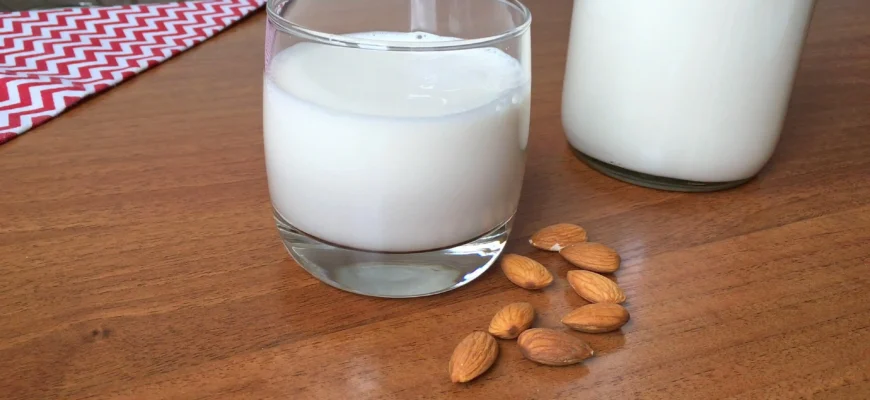Making almond milk at home isn’t just an eco-friendly and cost-effective option; it’s a fun and healthy alternative to dairy that’s gaining popularity among all kinds of people. Whether you’re lactose intolerant, vegan, or just looking to switch up your morning routine, almond milk is a delicious and versatile option. So, let’s get into the nuts and bolts of how to make almond milk at home, and I’ll throw in a few helpful tips and considerations along the way.
What is Almond Milk?
Almond milk is simply a plant-based beverage made from almonds and water. It’s a popular alternative to cow’s milk due to its light texture, slightly nutty flavor, and lack of dairy. You can buy it at almost any grocery store, but making it from scratch has a few big advantages – namely, freshness and control over the ingredients. Plus, there’s something inherently satisfying about creating something wholesome with your own two hands.
Ingredients Needed
To make almond milk at home, you need:
- 1 cup raw almonds
- 2-4 cups water (depending on how thick you want your almond milk)
- Optional sweeteners/flavorings: 1-2 tablespoons maple syrup, a pinch of salt, a teaspoon of vanilla extract, or a couple of dates for natural sweetness.
- Optional thickener: 1-2 tablespoons of coconut oil (if you like your almond milk creamier).
How to Make Almond Milk: Step-by-Step
- Soak the Almonds
Start by soaking 1 cup of almonds in water for at least 12 hours (or overnight). This step softens the almonds and helps release the nutrients. It also makes the almonds easier to blend and creates a smoother milk texture. If you’re in a rush, a quick 1-2 hour soak can also work, but longer is better. - Drain and Rinse
After soaking, drain the almonds and rinse them well. You’ll notice they’re plumper and softer – this is a good sign! - Blend the Almonds
Add the soaked almonds to a high-speed blender along with 2-4 cups of water. The amount of water depends on how thick you want your almond milk. For a creamier milk, use less water; for a thinner, more liquid consistency, use more. Blend on high for about 2 minutes, until the almonds are fully broken down, and the mixture becomes smooth and frothy. - Strain the Milk
To separate the almond milk from the almond pulp, pour the blended mixture through a nut milk bag, fine mesh strainer, or cheesecloth into a large bowl or pitcher. Gently squeeze or press to extract as much liquid as possible. - Optional: Sweeten and Flavor
If you like your almond milk sweetened, you can add maple syrup, vanilla, a pinch of salt, or even a couple of dates while blending. Just blend again for a few seconds to combine. The dates will blend in naturally without leaving chunks, and you’ll have a lightly sweetened milk. - Store
Transfer your fresh almond milk to a sealed glass container and refrigerate. It’ll last about 3-4 days. Don’t forget to shake it before use, as homemade almond milk tends to separate.
What About the Almond Pulp?
After you’ve strained the almond milk, you’ll be left with almond pulp. Don’t throw this away! It’s packed with fiber and can be used in a variety of ways. You can dry it out in the oven and use it in smoothies, baked goods, or energy balls. It’s an excellent addition to granola, or you can simply mix it into oatmeal. It’s a shame to waste such a nutritious byproduct!
The Health Benefits of Almond Milk
Almond milk is often praised for its health benefits. Here are a few:
- Low in Calories: Compared to whole milk, almond milk is much lower in calories, making it a good option for those watching their weight. Just keep in mind that some store-bought versions may contain added sugars, so homemade almond milk is a healthier option.
- Rich in Vitamins and Minerals: Almonds are a good source of vitamin E, magnesium, and healthy fats, which contribute to improved heart health, brain function, and overall well-being.
- Dairy-Free and Lactose-Free: Almond milk is naturally free from dairy, so it’s an excellent choice for those with lactose intolerance, vegans, or people who simply prefer plant-based products.
- May Help Reduce Cholesterol: The monounsaturated fats found in almonds may help reduce bad cholesterol levels and promote heart health.

Things to Consider When Making Almond Milk
While making almond milk at home is incredibly simple, there are a few things you should keep in mind:
- Potential Almond Allergies: Some individuals are allergic to almonds or nuts in general, so always make sure that everyone consuming your almond milk is not allergic.
- Nutritional Profile: Homemade almond milk, unlike many store-bought versions, is often not fortified with calcium and vitamin D. If you’re using almond milk as a replacement for cow’s milk in your diet, consider adding supplements or consuming other sources of these nutrients.
- Texture: Homemade almond milk may not have the same smooth texture as the commercial variety, which can contain stabilizers and emulsifiers. If you find that your homemade almond milk separates too much, just shake it up before use, or try blending in a little coconut oil or oats to help it stay creamy.
- Waste Management: Making almond milk generates pulp, and while it’s useful, it can feel like extra waste if you don’t have a plan for it. Use it up quickly or store it in the fridge to use in recipes later. Or get creative and add it to your compost pile!
A Few Ways to Use Almond Milk
Almond milk is incredibly versatile. Here are some ideas for using it in your daily routine:
- In Smoothies: Swap out regular milk for almond milk in smoothies for a dairy-free twist.
- In Coffee or Tea: Almond milk makes a nice alternative to dairy in coffee, especially lattes. The slightly nutty flavor complements espresso beautifully.
- Baking: Use almond milk in baking recipes that call for milk, like cakes, muffins, or pancakes.
- In Cereal or Oatmeal: Almond milk works wonderfully with cereal or oatmeal – it’s light and adds a nice creaminess without being heavy.
Real Opinions on Homemade Almond Milk
I reached out to a few people to get a variety of opinions on homemade almond milk. Here’s what they had to say:
Maria, 42, Spain
“I’ve been making almond milk for years, and I love it. I control exactly what goes into it – no weird preservatives or sugars. The texture is a bit different from the store version, but I actually prefer it that way. The biggest challenge is the pulp – I always have to find something to do with it!”
James, 55, USA
“I started making almond milk because of my lactose intolerance, and it’s been a game changer. It’s easy to make, and I like that I can add my own sweeteners. My only issue is that homemade almond milk doesn’t have as much calcium as the store-bought ones. So, I make sure to get my calcium elsewhere.”
Ayesha, 30, India
“I find that homemade almond milk tastes fresher and less ‘processed.’ I use it in my morning chai, and it’s perfect. But, like many people, I also struggle with what to do with the almond pulp. It’s a little time-consuming to make, but I try to make a big batch to last a few days.”
Omar, 28, UAE
“I tried almond milk for the first time a few months ago. Honestly, I didn’t like the store-bought versions, but homemade almond milk is far superior. It’s much smoother and doesn’t have that weird aftertaste. The downside? It doesn’t last as long as the commercial stuff, so I end up making a new batch every few days.”
Li, 63, China
“I’ve been making almond milk for about six months. I drink it as a replacement for regular milk in my tea. It’s healthy, but I did miss the thickness of cow’s milk at first. I now add a bit of coconut oil to make it creamier – problem solved!”
Conclusion
Making almond milk at home is simple, fun, and incredibly rewarding. With just a few ingredients and a little time, you can enjoy fresh, creamy almond milk whenever you like. It’s a great alternative to dairy, with plenty of health benefits – but like anything, it’s important to be mindful of your specific dietary needs and preferences. Whether you’re using it in coffee, baking, or just sipping on a cold glass, homemade almond milk is a delicious and wholesome option that’s well worth trying. So go ahead, get nutty in the kitchen, and enjoy!









